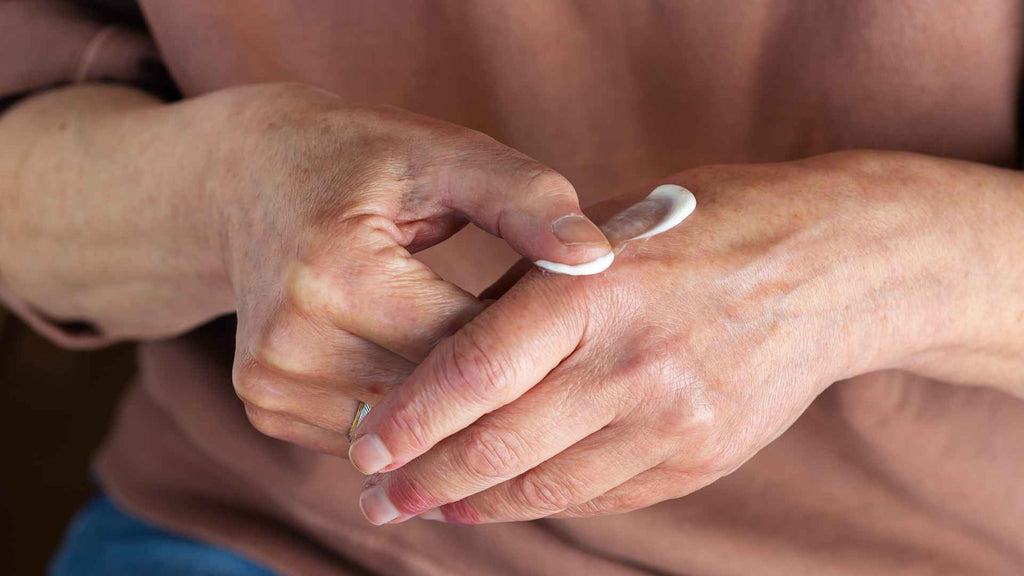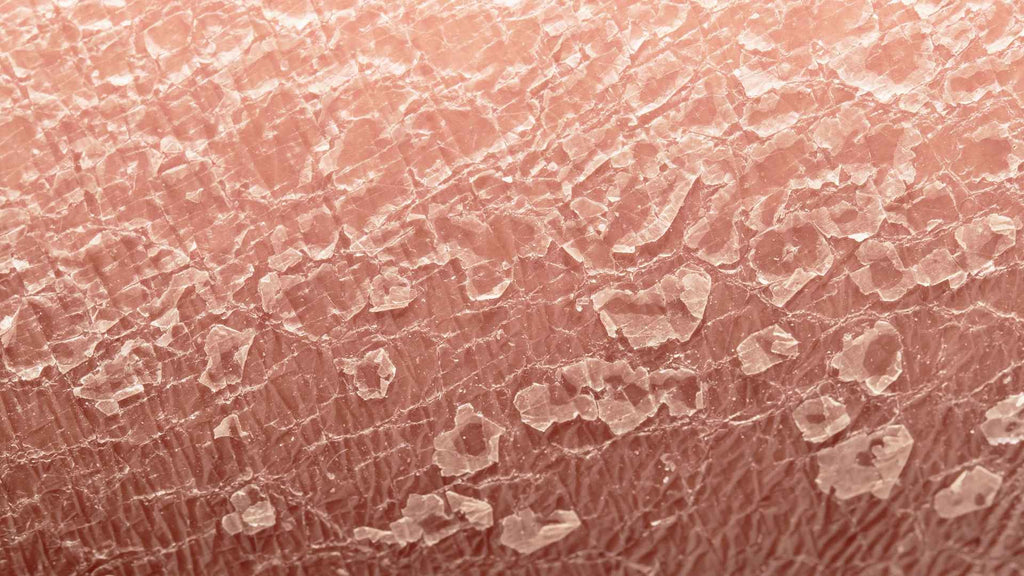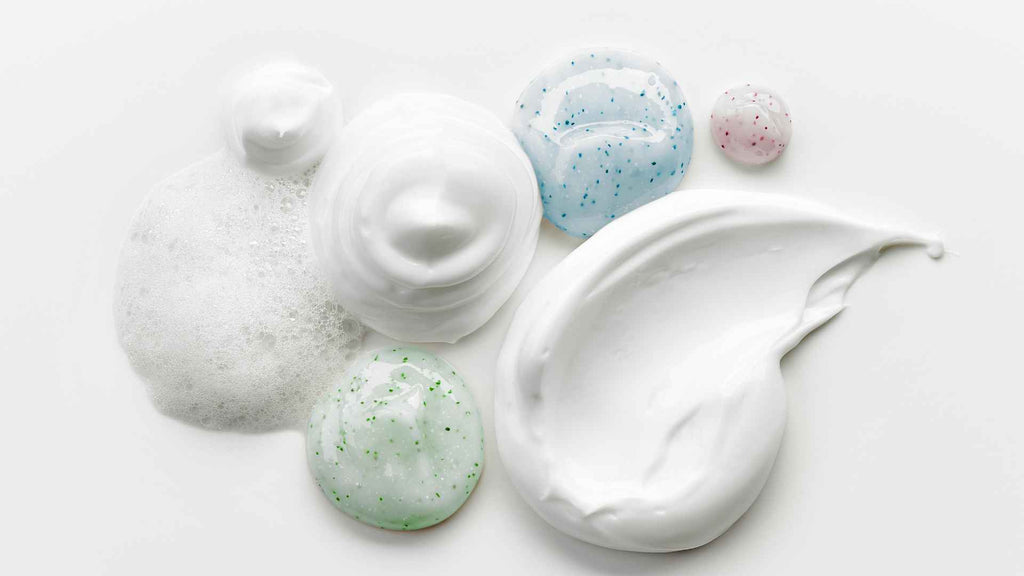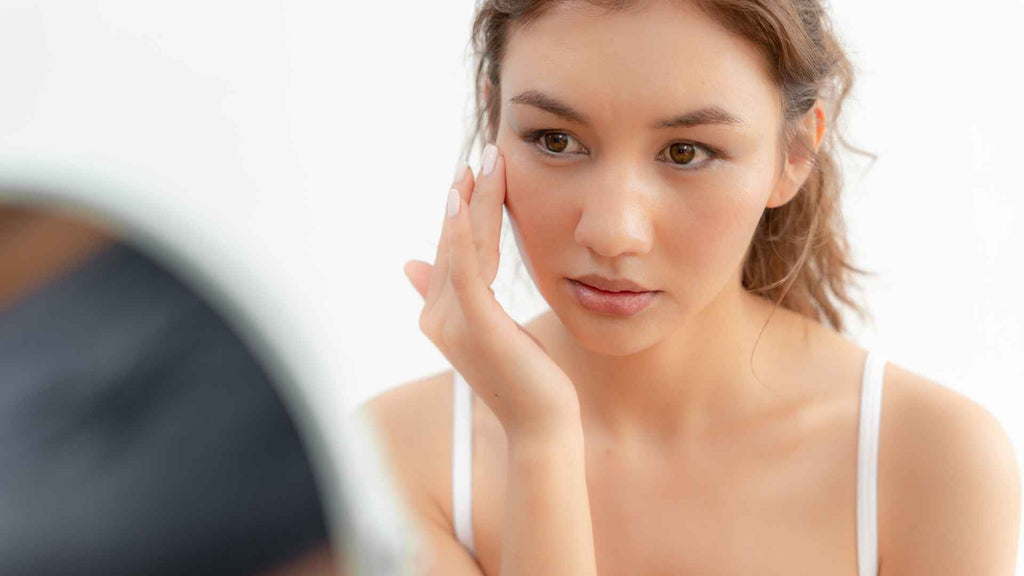TL;DR
是的,使用类固醇霜确实会导致永久性皮肤变薄,特别是如果您使用高效霜 在很长一段时间内。当涂抹到身体的敏感区域(例如脸部、腹股沟和腋窝)时,这种风险会增加,这些区域的皮肤本来就较薄。
为了避免皮肤厚度和健康状况发生不可逆转的变化,最好完全避免使用外用类固醇并使用更安全的选择。如果您的治疗需要使用局部类固醇,请确保坚持使用最低有效效力,并严格遵守医疗服务提供者关于短期使用的指南。
如果您发现皮肤干燥、起皱或容易瘀伤等迹象,则表明需要重新评估您的治疗。探索替代疗法和恢复路径可以提供最小化风险和支持皮肤恢复的方法,让您更清楚地了解如何保护皮肤的完整性。
类固醇引起的皮肤变薄
如果您曾被指责脸皮薄,那么有人可能会建议您无法承受一些轻微的批评或笑话。但对于那些使用局部类固醇的人来说,皮肤变薄和其他皮肤疾病可不是闹着玩的。

事实上,这个笑话可能是针对我们的,我们公众已经了解到氢化可的松和皮质醇等外用皮质类固醇对于治疗牛皮癣、湿疹和许多其他皮肤病是完全安全的。
外用皮质类固醇随处可见,在世界各地的药店都可以找到。然而,皮肤病学界的一个公开秘密是,使用这些常见药物确实存在危险。
局部类固醇效力的副作用
了解类固醇霜的功效至关重要,因为它直接影响导致永久性皮肤变薄的风险。
高效外用类固醇虽然对某些情况有效,但具有显着的皮肤萎缩风险,尤其是长期使用皮质类固醇。这些强效制剂的效果在皮肤本来就较薄的部位(例如脸部和腹股沟)更为明显。因此,必须使用最低有效效力,在不损害皮肤完整性的情况下提供缓解效果。

皮质类固醇与永久性皮肤变薄之间的联系已有详细记录,强调遵守规定指南的重要性。长期使用高效类固醇会显着增加发生这种损害的可能性。因此,监测皮肤对治疗的反应并咨询您的医疗保健提供者以根据需要调整配方效力或药物浓度至关重要。
需要注意的是,如果您已经长期使用外用类固醇,则不应立即戒掉。突然停止使用强效类固醇霜也会导致皮肤变薄。这种突然停止可能会震动您的皮肤,导致皮质类固醇戒断,并可能加剧萎缩的风险。
为了最大限度地降低这些风险,请在皮肤科医生或医疗服务提供者的护理下遵循逐渐减少的方法。这样,您可以确保您的皮肤在逐渐减少使用时适当调整并保持健康。
持续时间和频率
您使用的时间越长、越频繁类固醇霜,您出现永久性皮肤变薄的风险就越高。这是因为使用时长和频率在确定您是否会面临永久性皮肤损伤方面发挥着重要作用。如果您长时间或每天多次使用类固醇霜,则会增加皮肤受损的机会。

偏离处方的使用指南可能会导致严重后果。为了保持皮肤健康并避免不可逆转的变薄,遵循提供的治疗说明非常重要。
局部类固醇戒断
除了皮肤变薄之外,使用局部类固醇的另一个大风险是称为局部类固醇戒断或 TSW 的病症。
这是停止长期使用强效外用皮质类固醇后可能发生的现象。它的特点是反弹效应,皮肤在适应不服药的情况下会出现各种戒断症状。
这种类固醇引起的皮肤状况与对其他类型物质上瘾的人可能经历的戒断症状类似。
局部类固醇引起的戒断副作用可能包括发红、烧灼感、瘙痒和皮肤剥落,通常发生在涂抹类固醇霜的区域。

TSW 的持续时间和严重程度因人而异,有些人出现轻微症状但相对较快地消退,而另一些人可能面临更长时间和更强烈的戒断过程。
对于经历 TSW 的个人来说,向在处理这种情况方面经验丰富的医疗保健提供者寻求医疗建议和支持至关重要。
如上所述,TSW 的管理策略通常包括逐渐减少类固醇药物的用量,以尽量减少反弹效应的风险。此外,注重保湿和保护皮肤屏障的护肤程序可以帮助缓解与 TSW 相关的一些不适。在严重的情况下,医疗保健提供者可能会推荐替代疗法来解决戒断症状并支持皮肤恢复。
总体而言,对 TSW 及其潜在影响的认识对于使用外用皮质类固醇的个体至关重要。通过了解与长期使用和正确停用这些药物相关的风险,个人可以就其护肤方案做出明智的决定,并在需要时寻求适当的指导。
受影响的皮肤区域
了解使用类固醇霜的时间和频率很重要,但考虑使用部位也同样重要。 皮肤变薄或萎缩在使用类固醇霜时存在显着风险,特别是在敏感区域 例如您的脸部、腹股沟和腋窝。这些区域更容易受到强效类固醇的不利影响,使其成为皮肤萎缩和永久性损伤的主要目标。

萎缩会导致皮肤干燥、起皱、容易瘀伤等症状,同时还会出现毛细血管扩张和皮纹。同样重要的是要注意,使用封闭敷料和氟化类固醇会增加皮肤永久性变薄的风险。这些做法会增强面霜的效果,使您的皮肤进一步不可逆转的损伤。
发现这些症状后,请联系您的医生讨论停止使用类固醇霜。这是防止进一步损伤并可能阻止皮肤变薄进程的最佳选择。
请记住,您的皮肤健康至关重要,识别最危险的区域可以帮助您就类固醇霜的使用做出明智的决定。
替代治疗选项
探索局部类固醇的替代治疗方案可以大大降低因长期使用类固醇霜而导致皮肤进一步变薄的风险。
有很多治疗方法可以帮助您恢复皮肤健康,而不会产生与类固醇相关的副作用。钙调神经磷酸酶抑制剂和维生素 D 类似物是其中的杰出例子,可以在不影响皮肤厚度的情况下提供缓解。

在日常护肤中使用润肤剂和保湿剂可以改善皮肤的水合作用和厚度,有助于抵消类固醇使用的影响。这些产品可以舒缓和修复皮肤屏障,保持水分并促进皮肤健康。
对于那些寻求更先进治疗的人来说,光疗或光疗提供了一个有前途的选择。这种非侵入性治疗使用特定波长的光来刺激皮肤修复和再生,无需刺激性化学物质即可解决皮肤变薄问题。此外,富血小板血浆 (PRP) 疗法已成为促进胶原蛋白生成的创新方法,从而改善皮肤厚度和弹性。
开始任何治疗之前请咨询皮肤科医生,以获得适合您皮肤需求的个性化选择。
Dermeleve®:快速有效地舒缓皮肤,不含类固醇
虽然这些替代疗法已经使用了一段时间,但与外用类固醇的功效、速度和负担能力相比,它们往往存在不足。
这就是Dermeleve®介入的地方。
简单地说,Dermeleve® 是一种作用更快、更持久、比外用类固醇更安全的止痒替代品。
Dermeleve® 的与众不同之处在于它能够快速开始发挥作用并持续长时间发挥作用,这与许多可能无法同时提供这两种功效的类固醇乳膏不同。
Dermeleve®的用户几乎可以立即感受到它的舒缓效果。这个快速行动至关重要,因为它有助于阻止抓挠的冲动,否则会使皮肤状况恶化。而且,这种缓解并不是短暂的。效果持久,这意味着您无需不断地重新涂抹面霜。
Dermeleve® 最好的一点是它可以安全地日常使用在身体的任何部位,包括敏感区域。由于它不含类固醇,因此您不必担心常见的副作用,例如通常与类固醇乳膏有关的皮肤变薄。
Dermeleve® 还富含滋润和滋养皮肤的成分,促进整体皮肤健康和恢复。这可以确保您的皮肤不仅感觉更好,而且会随着时间的推移而改善。
对于寻求快速且持久的皮肤瘙痒和刺激解决方案的人来说,Dermeleve® 可能正是您所寻找的。它兼具快速缓解和持续有效的功效,且没有类固醇带来的风险,使其成为管理皮肤状况的值得关注的选择。
使用外用类固醇时防止皮肤变薄
您可能已经在使用外用类固醇,并且想知道如何防止自己损伤皮肤。

以下是一些有助于减轻萎缩风险并保持皮肤健康的策略:
-
选择正确的效力: 始终从可缓解皮肤状况的最低有效效力的外用类固醇开始。请咨询您的医疗保健提供者以确定最合适的配方。
-
限制持续时间和频率: 尽可能短地使用类固醇霜,并且只能按照医疗保健提供者建议的频率使用。长时间和过度使用会增加皮肤变薄的风险。
-
小心地将类固醇涂抹到敏感区域: 在面部、腹股沟和腋窝等敏感区域涂抹类固醇时要格外小心。这些区域更容易变薄,因此请考虑使用效力较低的类固醇或医疗保健提供者推荐的替代治疗方法。
-
遵循逐渐减量时间表: 如果您已经使用外用类固醇较长时间,请勿突然停止。与您的医疗保健提供者合作,逐渐减少使用,以避免戒断症状,并最大限度地减少进一步皮肤损伤的风险。
-
使用防护服: 如果可能,请在治疗区域穿防护服,以减少直接暴露和物理刺激,否则会加剧皮肤变薄。
-
加入屏障修复霜: 为了支持皮肤的天然屏障,请在日常护肤中加入屏障修复霜或润肤剂。这些可以帮助保持水分、改善皮肤纹理并减少频繁使用类固醇的需要。
-
定期皮肤评估: 与您的皮肤科医生或医疗保健提供者安排定期检查,以评估您的皮肤健康状况。这些评估可以帮助检测稀疏的早期迹象,并允许调整您的治疗计划。
-
自我了解类固醇类型: 了解非氟化类固醇和氟化类固醇之间的差异,因为氟化类固醇导致皮肤变薄的风险较高。与您的医疗保健提供者讨论这些选项。
-
采取温和的护肤程序: 使用温和、无刺激性的洁面乳和保湿霜,以避免进一步给皮肤带来压力。避免机械去角质或刺激性成分,这些成分会剥夺皮肤的天然油脂。
-
随时了解替代疗法: 积极与您的医疗保健提供者讨论替代疗法。钙调神经磷酸酶抑制剂或维生素 D 类似物等选择可能适合控制您的病情,且不会带来皮肤变薄的风险。
遵循这些指南可以显着降低皮肤永久性变薄的风险,同时仍然可以通过外用类固醇有效管理您的皮肤状况。永远记住,与您的医疗保健提供者的开放沟通是安全使用类固醇和保持皮肤健康的关键。
监控和恢复
为了有效跟踪类固醇引起的皮肤变薄的愈合过程,必须使用超声波或皮肤卡尺等专业工具定期监测皮肤厚度。这种皮肤厚度监测不仅有助于跟踪恢复进度,而且在萎缩逆转评估中发挥重要作用。并非所有恢复期都相同。它会根据皮肤类型变异性、类固醇使用影响的持续时间以及类固醇效果的效力而变化。

增强胶原蛋白生成刺激对于帮助恢复过程非常重要。无论是通过特定的护肤产品还是专业治疗,增加胶原蛋白的生成都可以极大地促进使用类固醇后所需的皮肤再生支持。
认识到彻底的护肤程序的重要性也很重要。深思熟虑的方案对于
总结
简而言之,您必须谨慎使用类固醇乳膏,因为它们可能会导致永久性皮肤变薄。
类固醇的效力、使用频率和时长以及治疗皮肤的哪些区域都起着关键作用。
请记住,这一切都是为了在有效缓解和保持皮肤健康之间找到平衡。
了解皮肤变薄的潜在风险并探索更安全、有效的替代品(例如 Dermeleve)® 可以对您的皮肤健康和外观产生显着影响。
Dermeleve® 为那些寻求缓解瘙痒和刺激而又没有与外用类固醇相关的副作用的人提供了一种有前景的解决方案。它旨在提供快速、持久的缓解效果,使其成为您日常护肤的宝贵补充。
如需详细了解 Dermeleve® 如何帮助安全有效地管理您的皮肤状况,请访问 www.dermeleve.com。
您准备好以更安全的方法优先考虑皮肤健康?
常见问题解答
问:使用皮质类固醇会导致皮肤萎缩?
答:是的,长期使用皮质类固醇会导致皮肤萎缩,即由于皮肤细胞的大小和功能下降而导致皮肤变薄。
问:类固醇引起的皮肤萎缩有哪些症状和体征?
答:类固醇引起的皮肤萎缩的症状可能包括皮肤薄而透明、容易瘀伤和出现妊娠纹(条纹)。
问:皮质类固醇戒断是否与皮肤问题相关?
答:是的,皮质类固醇戒断可能会导致皮肤出现反弹效应,例如红斑、紫癜、毛细血管扩张和其他皮肤变化。
问:皮质类固醇会对皮肤血管造成永久性损伤?
答:长期使用皮质类固醇会导致皮肤损伤,包括血管扩张和减弱,从而导致毛细血管扩张。
问:局部类固醇戒断对皮肤有何影响?
答:局部类固醇戒断可能会导致一系列皮肤症状,例如红斑、红斑、快速耐受,甚至皮肤变薄(称为萎缩)。
问:皮质类固醇引起的皮肤萎缩的发病机制是什么?
A:皮质类固醇引起的皮肤萎缩的发病机制涉及抑制胶原蛋白合成和成纤维细胞功能,导致真皮和表皮萎缩。
问:如何在不使用长期外用类固醇的情况下治疗皮肤病?
答:皮肤病可以使用替代疗法来治疗,例如维甲酸、选择性糖皮质激素受体激动剂或其他不涉及长期局部类固醇使用的皮肤病治疗方法。


